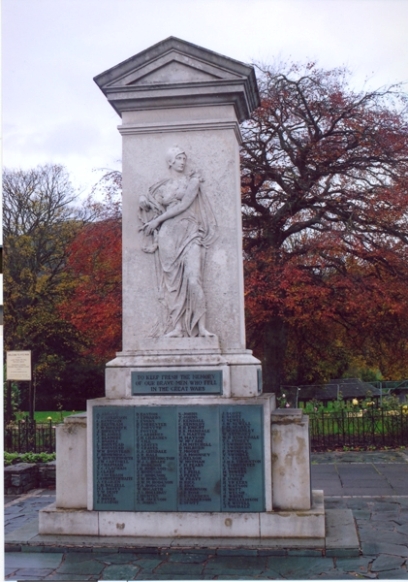A Keswick War Memorial; a Keswick Sculptor
The unveiling of Keswick War Memorial took place on Sunday 21st May 1922. The figure of Victory, crowning a sheathed sword with a laurel wreath in memory of the dead, was carved in high relief. This was the work of Mr Derwent Wood RA, a native of the town. Erected in Portland stone the monument cost around £1,500.
Francis Derwent Wood was born in on 15th October 1871 at Eskin Place, Castlerigg, St John's, Keswick, the fourth son of Alpheus Bayliss Wood of Philadelphia, USA, pencil mill manager and Ann Mary Maw of Ironbridge. In 1887 Wood worked as a modeller for the family firm of Maw and Co, tile manufacturer of Ironbridge. A student at the Royal Academy Schools from 1894 he won a year's travelling scholarship which took him to Paris where he befriended Gauguin. A founder member of the Society of British Sculptors he was responsible for numerous public monuments.
His portraits are remarkable for their modelling and character. Henry James, TE Lawrence Marshall Foch are among many whose vigorous and animated features reveal the artis'ts greatest strength.
Wood joined the Royal Army Medical Corps in 1915 as an orderly and he used his modelling skills to develop a technique for masking facial disfigurements.
He was responsible for a number of war memorials. Perhaps his most famous memorial is his Machine Gun Corps monument in London. During the war almost 14,000 officers and men of the Corps had been killed and another 48,000 were wounded, missing or prisoners of war. The main focus of the memorial is Wood's nine feet tall bronze figure of David. Naked, David strikes a confident pose, with right hand resting on his hip and left hand holding the outsize sword of Goliath. The inscription, from the book of Samuel, caused something of an uproar. It read; 'Saul has slain his thousands, but David his tens of thousands'.
Wood did other war memorials at Ditchingham [a dead soldier] and Whitehaven where he sculptured a relief of Victory.
Wood's most controversial work was entitled Canada's Golgotha. The three foot high bronze relief showed an alleged incident from 1915 when German soldiers were accused of crucifying a Canadian sergeant with bayonets. Exhibited in 1919 the work had to be withdrawn following protest by the German government who demanded proof that the incident happened.
Francis Derwent Wood died of lung cancer in 1926.


